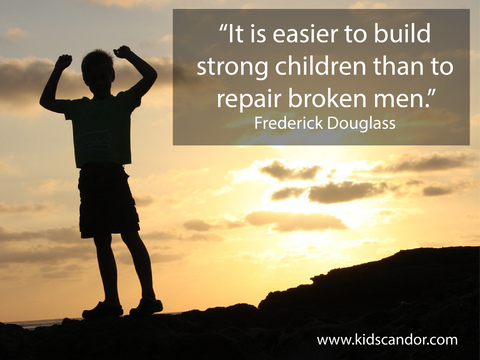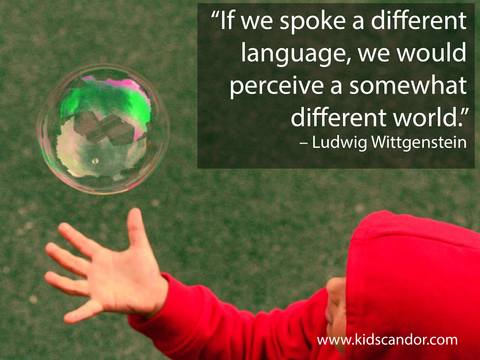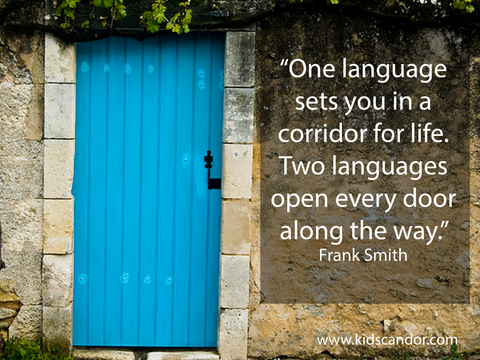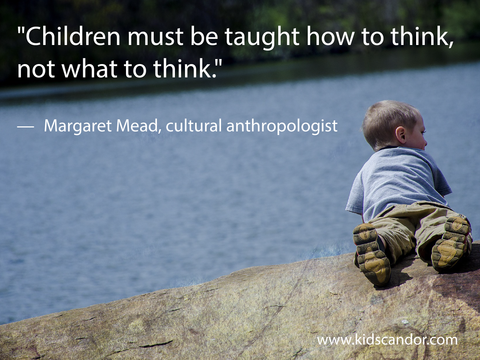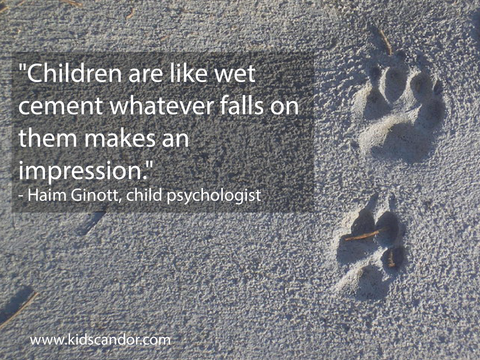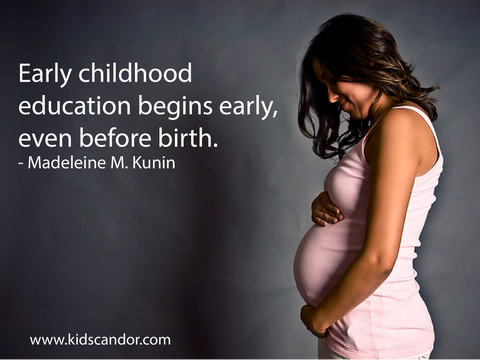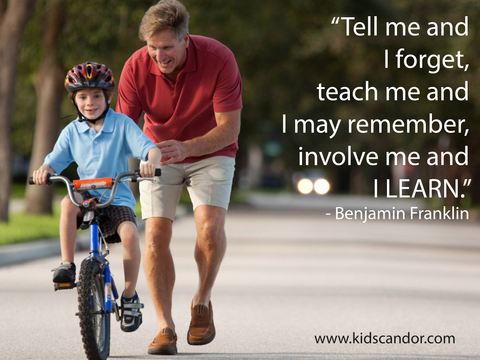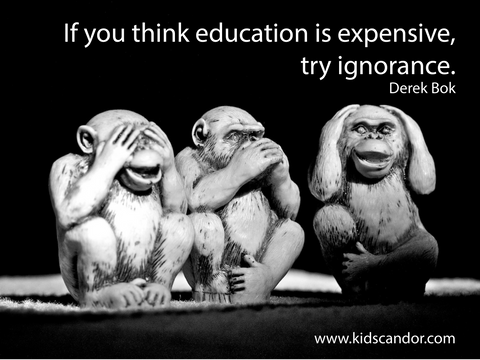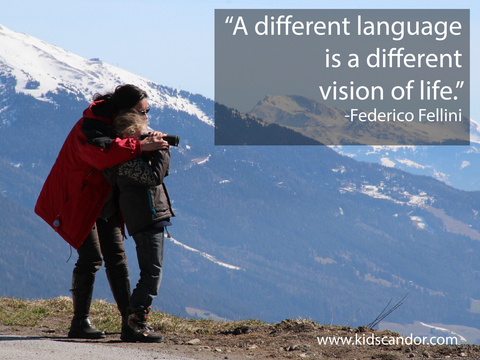10 Myths on Raising Bilingual Kids: Debunked
Throughout much of the world, history will show deliberate attempts have been made to forge monolingual societies through the elimination of minority languages.1 It is not surprising that, back in the day, research findings were consistently negative towards bilingualism.1 Even today, it’s hard not to come across comical (and sometimes downright weird) assumptions people make about raising children bilingually. In this article we have compiled 10 common myths on the subject with the purpose of debunking them. Hopefully this will help parents who are undecided about taking a step in the bilingual direction with their kids.

Myth #1: The world is mostly monolingual.
Not really. There are many more bilingual or multilingual persons than there are monolingual.2 More than half the world's population is bilingual.7 Furthermore, the number of kids that continue to be educated via a second (or third) language is greater than the number of children educated with one (first) language.2
Myth #2: It’s very difficult (or impossible) to teach my kids another language.
Nope. New technology, online instructors, curriculums, traditional methods such as language courses, are all readily available. Finding quality books and spending time reading with your kids goes a long way to help them learn any language.3 Targeted one stop solutions for toddlers (such as Kids’ Candor) makes this easy even for parents who do not know the other language. Bear in mind that, one way or the other, your kids do need plenty of exposure to the target language.3
Myth #3: My children won’t acculturate.
Actually, in homes where the parents come from a different culture, it’s the children who quickly acculturate and distance themselves from the culture and language of the family.3 Parents will be better able to connect with their children in their native language. Emphasizing the difference between cultures and languages yields well rounded and empathetic kids.3
Myth #4: Raising my child bilingually can cause a delay in development.
Wrong. This is no longer an accepted view.9 In fact, there are several advantages, such as improved executive function, metalinguistic awareness, mental flexibility and creative thinking. Bilingual kids generally meet developmental milestones within the normal range of language development.4
Myth #5: If my child has developmental challenges or learning disabilities, then learning a second language will make it even harder for them.
Wrong again. Studies that compared bilingual children with SLI (specific language impairment) to monolingual children with SLI found that the bilingual kids showed equivalent levels of language-related strengths and weaknesses to the monolingual group.5 The same goes for children with developmental disorders, such as Autism.5
Myth #6: My child will confuse the two languages
Even in the earliest stages of language acquisition, there is no evidence to support this.5 Children are not confused by hearing more than one language.9 All bilingual speakers of all ages sometimes mix their languages. This is called code-switching.5 It does not mean the child is confused – just means the child “can” switch at will.
Myth #7: To raise my child bilingual, I should use the one person - one language approach.
Incorrect. There are several ways to raise a kid bilingually, e.g: caregiver 1 speaks one language and caregiver 2 speaks the other; one language is used in the home and the other outside the home; the child gets his/her second language at school, etc. What’s important is the kid must understand that he/she needs two or more languages in everyday life.7
Myth #8: If my children are raised bilingually, they’ll have problems to read.
Absolutely not. Speaking and listening to several languages won’t damage the ability of your child to read. Some suggest to let your child learn how to read in the language spoken at school, so that he/she’ll get the most support there.6
Myth #9: It’s better to wait for my child to master one language before introducing a new one.
False. Experts suggest the 'optimal' time for learning a second language is 'at the same time as the first language'.8 This is pretty straight forward –the sooner, the better.
Myth #10: If I’m not speaking my mother tongue to my children, they’ll get the same strong accent and make the same mistakes as me.
What? First of all, having an accent is not an indicator of language fluency.9 Secondly, accents change over our childhood and adolescence, and in many instances do not stabilize until the early 20s.8 Once kids start mingling with other children (around ages 2 or 3) they’ll start to learn their accent from their friends.
References
1) University of Canterbury, “Myths about bilingualism”, http://twolanguages.canterbury.ac.nz/?page_id=103
2) www.libraries.rutgers.edu, “A Global Perspective on Bilingualism and Bilingual Education: Implications for New Jersey Educators” by G. Richard Tucker http://www.libraries.rutgers.edu/rul/projects/arachne/vol2_2tucker.html
3) www.puravidamoms.com, “3 Common Myths About Raising Bilingual Children” by Keli Allen García
4) www.theconversation.com, “Debunking common myths about raising bilingual children” by Mark Antoniou, MARCS Institute for Brain, Behaviour and Development, Western Sydney University
http://theconversation.com/debunking-common-myths-about-raising-bilingual-children-50592
5) www.babbel.com, “Let's Bust Some Myths About Raising Bilingual Children” by Katrin Sperling
https://www.babbel.com/en/magazine/bilingual-parenting
6) www.expatriateconnection.com, “Busted: 10 Myths About Raising Bilingual Children”
http://expatriateconnection.com/busted-10-myths-about-raising-bilingual-children/
7) www.francoisgrosjean.ch, “Myths about bilingualism” by François Grosjean, University of Neuchâtel, Switzerland
http://www.francoisgrosjean.ch/myths_en.html
8) The Linguist List, “Bilingual and Multilingual Children: Two Perspectives” by Deborah D.K. Ruuskanen and Anthea Fraser Gupta
http://linguistlist.org/ask-ling/biling.cfm
9) www.bilingualavenue.com, “7 myths about bilingual individuals that may be holding you back!” by Marianna Du Bosq
https://www.bilingualavenue.com/7-myths-bilingual-individuals-may-holding-back/
Little and Big Explorers: The Motivation is the Same
Exploring makes us human
On Columbus Day we commemorate the landing of Christopher Columbus in the New World in 1492. It was his voyage that started the exploration and colonization of the Americas. Grown-ups like Columbus have felt the need to find out what lies beyond – just like our kids feel the need to explore the world. It seems it’s part of being human, and for the little ones, a key component of a healthy development.
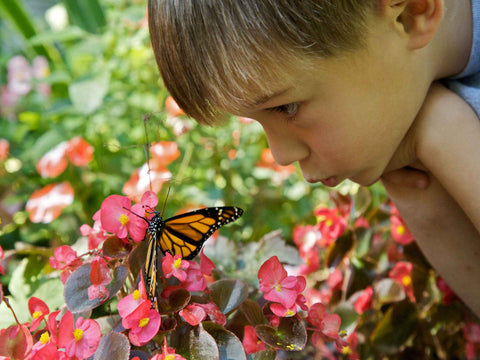
Same as for grown-ups, our children’s compulsion to see what lies beyond that ocean (or that closet door)—or this planet—is a defining part of their human identity and success.1 For kids, exploring means discovering their immediate surroundings, nature and the planet, and imagining going to far-away places. Our little ones are fascinated with how things work, what’s inside, and how they are built. Children learn by exploring their environment.7
Why do humans explore? “There’s a kind of madness to it. Sailing out into the ocean, you have no idea what’s on the other side. And now we go to Mars. We never stop. Why?”1 According to anthropologists, no other mammal moves around like humans do. “We jump borders. We push into new territory even when we have resources where we are. Other animals don’t do this.”1 It turns out the answer lies within our genes. There is a mutation of a gene called DRD4, which helps control dopamine, a chemical brain messenger important in learning and reward. The variant, carried by roughly 20 percent of all humans, is tied to curiosity and restlessness.1
From a developmental perspective, literature suggests that exploring ought to be encouraged in young children. “A toddler's interest in learning about the world encourages him to use his senses”7, while he will also sharpen his problem solving skills. It is also said to support social and emotional growth: a toddler explores her environment and returns to a parent when she needs help, thus becoming secure and confident.7 While exploring, toddlers also develop coordination in the muscles used to walk, run, climb and jump.7
The explorer spirit in our little ones can drive a healthy curiosity and learning about nature and our planet. To a great extent, this discovery takes place in the outdoors. Outside, toddlers learn to trust their bodies as they attempt more and more kinds of movement.3 Perhaps most importantly, by providing early experiences with nature, we support our children’s development of scientific and aesthetic thinking: “so they can ‘appreciate beauty, express creativity, and perceive patterns and variety in sensory dimensions of their worlds and themselves’”.2 Moreover, explorations of nature present great opportunities to introduce language and literacy. Experiencing real objects helps young children associate words with the objects they represent.4 Experts also suggest that introducing nature in the earliest stages of development, will make children more open to new ideas and skills, and will give them a greater understanding of our dependence on the earth’s physical environment.4
One step beyond is the benefit of learning about other countries and cultures through our kids’ natural tendency to explore. Children are naturally curious about maps and far-away lands. As children learn about the globe, they’ll start to recognize spatial distributions at all scales – which will help them understand the complex connectivity of people and places.8 Introducing our children to other peoples, will help them gain an appreciation for cultural diversity.9 Our children are already great explorers –with a little help and guidance from us, that natural trait will drive a healthy development and lots of learning.
There are tons of things we can do in our homes and outside to create better exploring opportunities for our little ones. Here is our list of top suggestions – let us know other creative ways in which you foster exploration with your kids.
Out in Nature
Collect natural items, such as rocks, sticks, sand, leaves, or flowers.2 Teach your child to gather them only for a good purpose (dry or press them or put them in a vase with water), but to never over-pick any plant or flower. “Teach your child to walk gently upon the Earth, taking only what she needs”.11 Observe butterflies and other insects. Compare different shapes of stones.
In the City
When walking outside, point out real-life urban examples of buses, trucks, cars honking horns, people crossing the street, vendors selling produce, etc., and people with their pets.3 Watch construction workers do their jobs; get close enough to lawn sprinklers to feel the drops. Step out when it’s raining or snowing: come back in and warm up together. Feed the ducks. Watch the clouds and the birds. Walk through a garden.3
Pick well-equipped playgrounds, preferably spaces that offer places where kids can dig holes and fill buckets.3
In the Grocery Store
Foster cultural diversity by selecting exotic vegetables at the produce section (like bok choy, for instance). Let the little investigators enjoy touching and smelling the stalks and observing the large green leaves. Get ready for a good meal!4
At Home
Baking and cooking usually involves props which enable toddlers to measure how much can fit in containers: cups, jugs, kettles, bottles, pots, saucepans, sieves, spoons, etc.5 Invite your little one to participate in the preparation of something fun. Like cookies!
Also, let your child wash plastic dishes with you. Or give her toys to play with in the bathtub (and be ready to mop up a mess!).7
Exploring the Globe
We can travel the world "virtually" via printed materials, community activities, and the Internet. Take advantage of activities in your area pertaining to other cultures, like food shows, folk dances, theatrical productions, and festivals. These are usually a lot of fun for children.9
Keep a map of the world in the house. Use it for play and education. Talking about the weather around the world is a great way to introduce kids to different countries, seasons and climates.10
---------------------------------------------------------------------------------------------------
References
1)www.ngm.nationalgeographic.com, “The New Age of Exploration” by David Dobbs
http://ngm.nationalgeographic.com/2013/01/125-restless-genes/dobbs-text
2)www.naeyc.org, “Exploring the Natural World with Infants and Toddlers in an Urban Setting” by Alyson E. Williams
http://journal.naeyc.org/Subscription/0108/Williams-An%20Urban%20Setting.pdf
3)www.scholastic.com, “Infants & Toddlers: Let's Go Outside!” by Alice Sterling Honig PhD
http://www.scholastic.com/teachers/article/infants-toddlers-lets-go-outside
4)www.naeyc.org, “Infants and Toddlers Meet the Natural World” by Jolie D. McHenry and Kathy J. Buerk
https://www.naeyc.org/files/yc/file/200801/BTJNatureMcHenry.pdf
5) www.ncca.ie, “Aistear: The Early Childhood Curriculum Framework: Exploring and Thinking”
http://www.ncca.ie/en/Practice-Guide/Aistear/Exploring-and-Thinking.pdf
6)www.kidshealth.org, “Safe Exploring for Toddlers”, reviewed by Mary L. Gavin, MD
http://kidshealth.org/en/parents/exploring.html?WT.ac=p-ra#
7)University of Illinois Extension, “Toddlers Exploring the World”
http://extension.illinois.edu/toddlers/exploring.cfm
8)www.planetfactory.com, “Why should your children be into geography?”
http://www.planetfactory.com/blog/why-should-your-children-be-into-geographyo
9)www.pregnancy.org, “Exploring That Big World Out There!”, by Lana Jordan
http://www.pregnancy.org/article/its-big-world-out-there
10)www.mamasmiles.com, “10 Tips for Raising Globally Aware Children”
http://www.mamasmiles.com/10-tips-for-raising-globally-aware-children/
11)www.childdevelopmentinfo.com, “Children are Little Scientists: Encouraging Discovery Plan” by Tim Seldin
https://childdevelopmentinfo.com/child-development/play-work-of-children/children-little-scientists/Laugh it Up
When it comes to kids, funny trumps serious…
“¿Qué le dijo un pez a otro pez?”
(“What did one fish say to another?”)
“¡Nada!” (this word has 2 meanings in Spanish: “nothing!” and “swim!”)
- Very funny for a 4-year-old girl…. -
Why people laugh and what humor means are not easy questions, yet we know something is funny when we see it or hear it. Our kids start doing the same as early as 18 months of age1. What is funny to them varies with their age, and some argue that little ones are only as humorous as their parents1. What is really interesting, though, is that besides triggering giggles, humor in our everyday interaction with our children is beneficial in ways we do not even imagine…and this no laughing matter. Check it out:

1) Humor is a way to teach discipline. It's a lot less stressful, and a lot more fun, to use humor and play to connect with our kids as we are setting limits and establishing discipline. Disciplining children with humor and play, “leaves everyone feeling much better than spanking children does.”7 For instance if diaper changing is a battle, instead of disciplining your kid in frustration, maybe chase her around the house, waving her diaper, while she's giggling, squealing and saying no – then you can fall down, she’ll laugh, etc.7
2) Humor helps develop children’s emotional intelligence. Among the key long-range emotional benefits of developing good humor skills during the early years is “the coping skill known to be associated with humor”4. In essence, humor helps kids gain better control of their own mood4, and this in turn will make them relate better with others.
3) Humor enhances children’s creative thinking skills. Research has shown that there is a close relationship between the mental processes involved in humor and other forms of creative thinking.4 For instance, the wordplay in double meaning jokes makes kids look at things from different perspectives, which is also key in the creative process.
4) Humor helps kids learn. While hearing or watching funny stories or funny books, children acquire new information. For example, all riddles contain background information about the world, in addition to the basic play on words. This information becomes part of “the child’s general knowledge base.”4 Humor is also said to be influential in brain development by means of increasing the flow of blood increases to the brain (when kids laugh). Also by helping children release tension, humor may increase the brain's receptivity to learning.2
5) Humor is a key part of our kids’ social skills. “Among both children and adults, humor is now understood to be one basic component of interpersonal competence”4. It is a very important social skill that will serve our kids well in the world and in interpersonal relationships going forward.4
So, get ready to do a lot more joking around with your little ones. It will certainly make life happier around the house for both, children and grown-ups, and you will be helping your kids be better persons. Don’t forget that a key to developing your kids’ sense of humor is to have fun as a family: telling funny stories jokes, playing games, watching funny movies and laughing together.3 Here are some very silly, age-appropriate ways to make your kids laugh:
Newborn to Age 1
- Rhythmically chant "tickle, tickle, tickle" culminating in a loving belly rub and lots of laughter.2
- Say "Uh-oh!" with a silly voice and face when your kid drops something.5
- Change your facial expression every time you reveal yourself, when playing Peekaboo.5
Ages 1 to 2
- Crawl and chase your child ("I'm gonna get you!") and reward the capture with hugs and kisses.5
- Encourage your child to imitate you, as you make funny faces.5
- Speak and sing in rhyme.5
Ages 2 to 4
- Sing silly old songs with silly choruses.5
- Put on a silly hat: something that is not a hat.
- Have fun with food: Make a smiley face with the food on the plate.5
Ages 4 to 6 (extremely silly jokes…)
- “Knock, knock”, “Who’s there?”: “Tank”. “Tank who?” “Tank you very much”.2
- "What's a purple gorilla called?” “A grape ape”.2
- “Why did the elephant paint her toenails red?” “So she could hide in the strawberry patch.”6
- “What did the baby ghost say to the bully ghost?” “Leave me alone or I’ll tell my mummy!”6
- “What’s the best month for a parade?” “March.”6
References
(1) www.dailymail.co.uk, “How children can get jokes from the age of two (but they are only as funny as their parents)” http://www.dailymail.co.uk/sciencetech/article-2346271/How-children-jokes-age-funny-parents.html
(2) www.scholastic.com, “Ages & Stages: Don't Forget to Laugh - The Importance of Humor”, by Susan A. Miller Ed.D., Ellen Booth Church, and Carla Pool http://www.scholastic.com/teachers/article/ages-stages-dont-forget-laugh-importance-humor
(3) www.kidshealth.org, “Encouraging Your Child’s Sense of Humor”, Reviewed by: Mary L. Gavin, MD http://kidshealth.org/en/parents/child-humor.html
(4) www.LaughterRemedy.com, “How Humor Facilitates Children’s Intellectual, Social and Emotional Development”, by Paul McGhee, PhD http://www.laughterremedy.com/articles/child_development.html
(5) www.parents.com, “Why Laughter Is a Sign of Learning”, by Emily Perlman Abedon http://www.parents.com/baby/development/laughing/why-laughter-is-a-sign-of-learning/
(6) www.psychcentral.com, “Humor As a Key to Child Development”, by Lawrence Kutner, Ph.D http://psychcentral.com/lib/humor-as-a-key-to-child-development/
(7) www.webmd.com, “The Lighter Side of Parenting - using humor to discipline and teach children”, by Gina Shaw
Embracing the Differences: Understanding bias is key to raising our kids without prejudice
Recent events and the ensuing heated political dialogue has made some of us think about the issue of bias, and what the right message to our children should be: should we ignore, explain or condemn what is bias and prejudice? Should we ignore or highlight differences among individuals/groups?
Most of us will agree that we all have a moral compass, and we would like to bring that out in our children. Being justice one of its pillars, the golden rule of treating others as we would like others to treat us prompts us to raise our kids without bias and prejudice

How we feel and how we behave might seem like two separate issues, yet they tend to merge together when it comes to our attitudes towards those who are different than us. That goes for both, parents and kids. As parents we need to be aware of our own potential for implicit bias (also known as implicit social cognition), which encompasses “the attitudes or stereotypes that affect our understanding, actions, and decisions in an unconscious manner”1. Take, for example, a woman or member of an underrepresented group who makes a point in a seminar, only to be ignored, and then a white male makes the same point a little later, only to be applauded for his insight5. This means, as role models we ought to be vigilant, since we could be eliciting biased behavior towards others without thinking we are.
On the other hand, and contrary to popular belief, studies show that our small children are not colorblind2. It seems they develop biases by ages three to five that do not necessarily resemble the attitudes of the adults who surround them2. Why? To start with, young children engage in something called “transductive reasoning” – when they see folks who are alike in one dimension (like color or gender), they think they are alike in other dimensions as well2. Kids do the same thing with objects, for instance, a child might assert that pizza is triangular in shape rather than round, because he/she has only seen single slices6.
Secondly, environments teach young children which categories seem to be most important and kids attach meaning to those social categories, without adult guidance2. For instance: “Good morning, boys and girls,” may help children infer that gender is an important social category, and they can then attach meanings to gender categories (e.g., “Girls are smarter.”)2, even if they don’t hear this from adults.
Honing on the point of social categorization4, a 2006 study (on the effects of adults' labeling and use of social groups on toddlers’ intergroup attitudes)3 showed that even in the absence of adult guidance, children developed biased attitudes as a result of simply assigning children to groups with different colors (“red or “blue”). As expected, when adults gave significance to the colors, the bias was greater3.
Making sense of all this and understanding bias is key to raising our kids without prejudice. Here are our top 5 suggestions to approach the issue sensibly with your young ones. We welcome your contributions and suggestions:
1 - Bring it up
Don’t think that young children do not notice differences or prejudice, and don’t avoid talking about it with your child in a meaningful way. The silence just keeps your child from talking about it2.
2 - Different is Beautiful
Highlight that diversity among people is a good thing, and that all colors, sizes, and shapes of people are beautiful.
3 - Be Vigilant
Watch out for manifestations of bias or biased behavior – remember children develop it on their own2.
4 - Explain
Clearly outline how biased behavior towards individuals is “not fair”. Kids have a strong sense of justice.
5 - Encourage complex thinking
Teach your child to pay attention to multiple attributes of a person or group at once, not just the most salient single one2.
----------------------------------------------------------------------------------
References
(1) Understanding Implicit Bias, The Ohio State University, Kirwan Institute
http://kirwaninstitute.osu.edu/research/understanding-implicit-bias/
(2) Children Are Not Colorblind: How Young Children Learn Race, Erin N. Winkler, Ph.D. University of Wisconsin-Milwaukee
https://www4dev.uwm.edu/letsci/africology/faculty/upload/children_colorblind.pdf
(3) Preschool children's attention to environmental messages about groups: social categorization and the origins of intergroup bias., Patterson MM, Bigler RS., US National Library of Medicine
http://www.ncbi.nlm.nih.gov/pubmed/16942493
(4) The Nature of Prejudice, Gordon Willard Allport, Perseus Publishing,1954
(5) What is Implicit Bias, Rutgers Department of Philosophy
(6) The Development of Mental Abilities, D. Elkin - Pearson Allyn Bacon Prentice Hall, www.education.com
http://www.education.com/reference/article/development-mental-abilities-children/
Read it, tell it, or make it up as you go along
Storytelling goes beyond just putting your kids to bed
Back in the day when there were no newscasts or newspapers, it was storytellers that kept communities informed by going from town to town spreading the word.
Even though we now read our news on tablets, we still love to hear the stories told out loud, and so do our children. There is a reason for that: “storytelling is perhaps the most powerful way that human beings organize experience” 5
 Telling stories and reading stories is not (or shouldn’t be) just something we do as a preamble to putting our kids to bed. It is said to open children’s minds to other cultures and life philosophies, while encouraging their imagination and creative thinking 1. It also instills virtues, as most stories have a moral, while making them aware of their own culture and roots 2. From a purely developmental perspective, story telling enhances verbal proficiency, listening skills, sharpens memory and helps to deal with difficult situations (by way of learning how problems are worked out in the stories) 2.
Telling stories and reading stories is not (or shouldn’t be) just something we do as a preamble to putting our kids to bed. It is said to open children’s minds to other cultures and life philosophies, while encouraging their imagination and creative thinking 1. It also instills virtues, as most stories have a moral, while making them aware of their own culture and roots 2. From a purely developmental perspective, story telling enhances verbal proficiency, listening skills, sharpens memory and helps to deal with difficult situations (by way of learning how problems are worked out in the stories) 2.
So this is great news, but how can we make the best out of our storytelling time? We can read stories, tell stories from our memory, or make up stories as we go along. For those of us interested in the latter two, we can look to our own past: perhaps invent a character and use our own past events to create adventures. One can also tell the story in the first person 1 and/or let he kid contribute his/her own ideas, or fill in the blanks. Experts say not too worry too much about content, but one should focus on the story structure, (especially - character, setting, problem & resolution) 4.
You can also read or tell stories to your child in whatever language you feel most comfortable speaking 3. By doing so you will communicate more easily, and your “child will still learn that words are made up of different letters, syllables and sounds, and that words usually link to the pictures on the page” 3. Dual-language books are a great resource, yet an alternative is to read a book in English and talk about it with your child in whatever language you are most comfortable with 3.
A great deal of literature and advice exists on storytelling for children. We have extracted the top ten tips we believe are the most valuable to optimize yours and your child’s story-time experience.

The What
- Kids usually like books, songs and stories that have good rhyme, rhythm and repetition 3.
- If telling stories, consider family stories 1, look to your own past 2, or for the stories you love or have heard, such as folktales 1.
- If reading books, let your child choose which ones when he’s old enough to start asking 3.
- Be prepared to read favorite books over and over again 3.
The Where
- The place should have a conducive mood and ambiance for storytelling 2. A comfortable reading chair can become part of your reading routine 3.
- Turn off the TV, tablets and other electronics, and find a quiet place to read so your kid can hear your voice 3.
The How
- Use proper hand gestures and facial expressions 2: try out funny noises and sounds – play and have fun! 3.
- Involve your child by using various phrases or by asking them questions 2, encouraging talk about the pictures, or by repeating familiar words and phrases3.
- Make a routine and try to share one book every day 3.
- Hold your child close while you read, so she/he can see your face and the book3.
References
(1) Storytelling for Children, by Pam Myers. Child Development Institute.
https://childdevelopmentinfo.com/child-activities/storytelling-for-children/
(2) 10 Benefits Of Storytelling For Kids by Palak Shah, momjunction.com
http://www.momjunction.com/articles/benefits-story-telling-yor-kids_0036903/
(3) Reading and storytelling with babies and children, by Raising Children Network.
http://raisingchildren.net.au/articles/reading.html
(4) The Art of Storytelling by Daryl Bellingham. storytell.com.au
http://www.storytell.com.au/artnscreat.html
(5) Storytelling in the First Three Years by Susan Engel, zwerotothree.org
https://www.zerotothree.org/resources/1057-storytelling-in-the-first-three-years
How Dads Really Matter: Is growing up with a dad really important?

It’s the time to celebrate Fathers’ Day and it inevitably makes us think about our own fathers but also about the importance of fatherhood: an idea often politicized and one that has usually been more contested than the importance of motherhood.
In the context of early childhood development, we are told that "even from birth, children who have an involved father are more likely to be emotionally secure, be confident to explore their surroundings, and, as they grow older, have better social connections.”6 Research has also found that early positive father-child interactions can reduce cognitive delay of infants and that father involvement can also improve weight gain in preterm infants and boost early language skills.1 Furthermore, the involvement of fathers in children’s lives at a young age has been linked to toddlers developing greater abilities to start school with higher levels of academic readiness. 1
In a 2008 speech, President Obama reminded us of the importance of family as the most important building rock of our lives and called “to recognize and honor how critical every father is to that foundation”. 3 A great deal of research would support that statement and the thesis that kids who grew up without a father are worse off than those who did have a loving father. Many studies show that children with fathers do better in school and are less likely to abuse drugs and alcohol, and that children without fathers are more likely to do jail time and are more prone to obesity, etc. 2
But is that comparison really accurate? These studies have traditionally compared households with a father and a mother against single mother households (fatherless). As quoted by Sciencedaily.com, Timothy Biblarz of USC and Judith Stacey of NYU found that the social science research that is routinely cited “does not actually speak to the questions of whether or not children need both a mother and a father at home. Instead proponents generally cite research that compares [heterosexual two-parent] families with single parents, thus conflating the number with the gender of parents."3
So how do kids who grew up with 2 moms fare? The same scholars found that there are far more similarities than differences among children of lesbian and heterosexual parents, according to the study 3. OK, so is having a father only important because two parents are better than one, or are male role models necessary?
Some say no, some say yes. For instance, one study conducted at the University of Amsterdam in 2012, found no evidence “that the associations between gender role traits and adolescent psychological well-being were different for girls and boys, or for those with or without male role models” 4. On the other hand, many argue that the importance of dads goes beyond that. Fathers are different than mothers: dads are not only capable of nurturing children, but they do it in ways, which are distinctly different from moms. The contrast in different approaches of essential activities such as play, feeding and bathing “fosters a capacity for children to attach to each parent as a separate individual with distinct relational styles” 5. That is for babies and toddlers, but there is also something to be said about young boys and young girls learning what a good dad is.
And that is perhaps the crux of the matter. It’s not about the importance of a father, but the importance of having and being a good father. And being a good dad has apparently little to do with one’s own gender, and everything to do with what we do and share with our children.
Happy Fathers’ Day everyone!
1) University of Florida - The Impact of Fathers on Children's Well-Being
Sarah M. Ellis, Yasmin S. Khan, Victor W. Harris, Ricki McWilliams, and Diana Converse
http://edis.ifas.ufl.edu/fy1451
2) The Importance of Fathers (According to Science). Brett and Kate McKay. http://www.artofmanliness.com/2015/06/19/the-importance-of-fathers-according-to-science/
3) Wiley-Blackwell. "Do children need both a mother and a father?." ScienceDaily. ScienceDaily, www.sciencedaily.com/releases/2010/01/100121135904.htm.
4)The Williams Institute, UCLA. Are Male Role Models Necessary?
Autostraddle By Marie Lyn Bernard http://williamsinstitute.law.ucla.edu/press/are-male-role-models-necessary/
5) The Alliance for Early Childhood. Father's Role in Early Child Development by Louis WEiss, Ph.D. http://theallianceforec.org/library.php?c=5&news=77
6) Ditta M. Oliker Ph.D., The Long Reach of Childhood. The Importance of Fathers Is Father's Day Real? https://www.psychologytoday.com/blog/the-long-reach-childhood/201106/the-importance-fathers
The Memory Game: Have we forgotten the importance of remembering?
Some history professors would tell us that remembering important things, events, people is important because it not only teaches us lessons for the future, but it tells us about who we are and how we got here. Our ability to remember is also an important skill to develop, for both adults and children: an ability that has been forgotten since we hardly have to remember anything, now that we have all the data we need at our fingertips – remember when we memorized all important phone numbers? maybe you don’t remember if you are in your 20’s.

The memory game, as some call it, or “matching pairs” is a game you can play with your young children to encourage the use of their memory skills. Children learn how to retrieve information in a relaxed setting while developing patience and perseverance 1. Not only is this activity said to contribute to young children’s cognitive development 3, but according to Unicef, it helps develop their ability to recognize similarities and differences, categories, logic, creativity (by assembling the cards on their own). They also learn more about the world surrounding them through the pictures that are displayed in front of them 2.
I recently started playing the memory game with my 4-year-old daughter (in Spanish it’s called “Encuentra la Pareja”). Laid cards face down on the floor – the deck contains pairs of identical images – as they are placed randomly you need to guess where the matching cards are, by lifting two cards. Every time you fail is your opponent’s turn. Through this process, players attempt to memorize the location of the pairs.
During early childhood, the process of learning is supposed to take place when repeated experiences promote the development of neuron networks 4. Opportunities to practice tasks that require memory (such as “Encuentra la Pareja”) improve learning. A number of digital versions of this game can be found online, but nothing replaces the one-on-one interaction of playing cards with your kid.
As I played with my daughter, I realized I had spent a good amount of time where she was engaged in an activity that developed a number of skills – not just memory: sportsmanship, strategy, counting, but most importantly we laughed and bonded. If my memory doesn’t fail me, I started letting her win - now she beats me at it.
----------------------------------------------------------------------------------
References
(2) http://www.unicef.org/earlychildhood/files/Activity_Guide.pdf
(3) http://www.livestrong.com/article/1000692-games-cognitive-development-during-early-childhood/
Daylight Savings: The Art and Science of Sleepy Time
Kids wont simply go to sleep because they are put to bed…

Well, it’s the week of Daylight Savings time and for some of us that means we start to get out of bed one hour earlier and to go to bed 1 hour earlier (hopefully). But what is the impact to the sleeping routine we have with our children?
Usually disruptive, since not unlike their parents, children’s bodies get used to sleeping at certain times, and when the clock changes it takes some time to get used to the new cycle.
A time change of even only one hour can affect your kid’s circadian rhythm and therefore his sleep schedule, for a few days. “Circadian rhythms allow us to stay awake during the day and to sleep at night,” says Psychologist and Sleep Disorders Expert William David Brown, Ph.D., with Children’s Medical Center (2).
In general, it would be safe to say that a great deal of the disconnect between the time our kids feel like sleeping and the times we want them to, is driven by our need to impose our own daily/nightly schedule on them. Oh, and there's also a ‘forbidden zone,’ - a time when sleep is almost impossible. “If you’re putting your toddler to bed during that forbidden zone, she won’t be able to sleep,” says Dr. Brown (2).
Selecting a bedtime for your toddler that does not match his or her internal body clock, can contribute to difficulties in getting him/her to fall asleep at night, according to a new University of Colorado Boulder study (1). “The study pinpointed the time when the hormone melatonin increased in the evening, indicating the start of the biological night” (1). A mismatch between bedtimes and the rise in the children’s evening melatonin production “increases their likelihood of nighttime settling difficulties" (1). According to the study, about 25 percent of toddlers and preschoolers have problems settling after bedtime (1).
The good news is, even though it’s likely that people are genetically predisposed to be “night owls” or “morning people,” circadian rhythms can be changed (2).
Here are a few common sense tips to accomplish just that:
- Adjust bedtime incrementally. If you're putting your toddler to sleep one hour or more before he’s ready to sleep you're going to face challenges. Delay your child's bedtime to match his rhythm, at the beginning. Then move it up 15- 20 minutes each time until you reach the desired bedtime (2).
- Don't try to wear your child out hoping to get him to sleep earlier - overtired children often actually take longer to fall asleep and may even resist sleep completely (3).
- Manage the lighting. Plan to turn off all television, computers (blue light), and other electronic devices at least 90 minutes before bedtime. Try to use night lights or lamps instead of overhead lights (2). Also, after the clock change, you could use room-darkening curtains in so your baby can’t see how light it is outside (4).
- Keep your child on a regular sleep schedule. For instance, don’t let your toddler stay up late on weekends, hoping that the child will sleep late in the morning (2).
References
(1) University of Colorado at Boulder reprinted by Sciencedaily.com, “Bedtime for toddlers: Timing is everything”, https://www.sciencedaily.com/releases/2013/12/131216155000.htm
(2) Childrens.com, Dr. William David Brown, Ph.D., “4 Secrets to Adjusting Your Toddler's Circadian Rhythm”, https://www.childrens.com/keeping-families-healthy/family-blog/category/health-topics/4-secrets-to-adjusting-your-toddlers-circadian-rhythm
(3) Kidspot.com, Ella Walsh, “Daylight savings and your child's sleep routine”,
(4)Thebump.com, “How To Help Baby With The Time Change”, http://www.thebump.com/a/baby-time-change,
Back to the Basics: Yesterday’s children games are powerful developmental tools
While most will speak wonders of innovation, there is something to be said about common wisdom and tradition, particularly when it comes to fun games to play with your kids.

Yes, the games our parents played when they were kids and that we then learned when we were kids, are not only great ways to connect with your little ones, but also have value from a developmental standpoint. These games have also spanned generations and also cultures and languages – in a way, they connect the childhood memories and experiences of millions of children and grown-ups across the world.
Let’s take a look at an all-time classic for babies and younger children: Peekaboo. It is a game played all over the world, that crosses language and cultural barriers. But the reason it’s so universal is maybe that it’s such a powerful learning tool (1). We love this game because babies do not cease to laugh with every repetition, but there is more to it. The key concept here is Object Permanence, a fundamental principle of existence: that things stick around even when you can't see them (1). Jean Piaget suggested that babies spent the first two years of their lives working this out (1).
Consider for instance Hopscotch, which by the way, has over 25 different names in Spanish only (depending on the country – like “Golosa” in Colombia and “Peregrina” in Puerto Rico) and many more in all other languages, all over the world. Yes, very culturally widespread, but also good for your kid’s development. How? Well, setting aside the obvious learning of the numbers from 1 to 10, it turns out that, because each turn the game is changing, kids have to think about how they are going to play it each round... hop-hop-leap-jump-hop-stop, etc (2). So they learn to plan and strategize (life-long skills). The game then allows children to execute their plan physically (2). Hopscotch also promotes social development, through peer relationships, sportsmanship (taking turns) etc., and last, but not least, the development of motor skills - believe it or not, hopping on one foot is one of the most complex movements the human body can perform (3).
And how about Simon Says? (In Spanish “Simón Dice”). We all know it’s an excellent and fun way to learn the body parts, but in addition it demands a great deal of executive function. That means it challenges children’s ability to pay attention, encouraging them to remember rules and exhibit self-control — qualities that also predict academic success (4). According to the NY Times, one study of 814 children between ages 3 and 6 shows that children who do well in Simon Says-like games do better in math and reading (4).
So there you have it. Those of us who want to optimize our children’s brain development often focus on things like flashcards and early reading, but we should not forget that playing games is a proven way to improve our kids’ skills. Those games we played when we were little may still have a few good generations left in them!
References
(1)BBC.com, Tom Stafford, “Why all babies love peekaboo”: http://www.bbc.com/future/story/20140417-why-all-babies-love-peekaboo
(2) D.K.’s Learning Center, “Hopscotch – What is phenomenal about this game?”
http://dkslearningcentre.blogspot.com/2014/05/hopscotch-what-is-phenomenal-about-this.html
(3)Gill Connell and Cheryl McCarthy ,“Why Hopscotch Matters”
http://movingsmartblog.blogspot.com/2012/06/why-hopscotch-matters.html
(4) The New York Times.com, Tara Parker-Pope, “Simon Says Don’t Use Flashcards”
http://well.blogs.nytimes.com/2012/08/23/simon-says-dont-use-flashcards/?_r=0
10 Inspiring quotes about childhood and languages
See all articles
